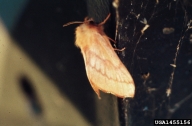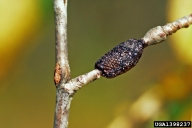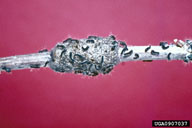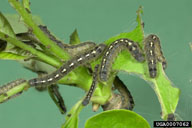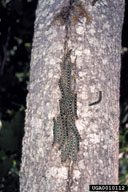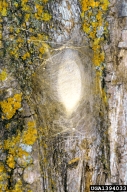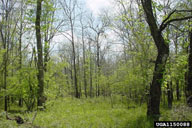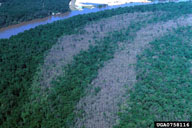Forest tent caterpillar
Malacosoma disstria Hübner (Lepidoptera: Lasiocampidae)
Orientation to pest
Forest tent caterpillar, Malacosoma disstria Hübner, occurs throughout Canada and the United States and is a generalist defoliator that feeds on a variety of hardwood trees. In the north and west of the United States (and southern Canada), trembling aspen (Populus tremuloides Michx.) is preferred. In the southern United States, various gums (Nyssa spp. and Liquidambar styraciflua L.) and oaks (Quercus) are the common hosts. However, during outbreaks, larvae will feed on a wide variety of hardwood species. Winter is passed as eggs, which hatch in spring. Larvae begin feeding on buds and expanding leaves. Older larvae feed on mature leaves. Young larvae feed in groups, but older larvae are dispersed. Larvae lay silk trails, which they follow, but they do not form a silken tent. Rather, they make silk mats on which larvae rest. Mature larvae wander and pupate inside a yellowish-white cocoon fixed to the host tree or other objects. Adults emerge in midsummer (north) or spring (south) and lay their eggs in clusters that encircle twigs of the host tree. Eggs are cemented together and covered with dark colored material called spumaline. There is one generation per year. A number of very large outbreaks, covering thousands of square miles and lasting for several years, have occurred in North America. Tree mortality is generally low, but loss of growth can be considerable (>70%) due to effects of defoliation. In the southern United States, in bottomlands, gum trees may die from defoliation. In the northeastern United States, defoliation of sugar maple stands lowers maple syrup yields and quality.
Hosts commonly attacked
This species is a generalist defoliator that feeds on a variety of hardwood trees. In the north and west, trembling aspen (P. tremuloides) is preferred. In the southern United States, gums (Nyssa spp. and L. styraciflua)and oaks (Quercus) are common hosts.
Images of forest tent caterpillar
| Figure 1. Adult of forest tent caterpillar, Malacosoma disstria | Figure 2. Eggs of forest tent caterpillar (left) and newly hatched caterpillars on egg mass (right) | Figure 3. Larvae of forest tent caterpillar feeding | |
| Figure 4. Larvae of forest tent caterpillar resting together on trunk | Figure 5. Forest tent caterpillar cocoon (with pupa inside) | Figure 6. Interior view of stand defoliated by forest tent caterpillar | Figure 7. Strips of water tupelo (Nyssa aquatica L.) defoliated by forest tent caterpillar (green areas are strips of less favored host species). |
Important biological control agents related to this pest species
The natural enemies of this species are well known and include 14 species of Hymenoptera egg parasites and, attacking larvae or pupae, 52 Diptera, and 61 Hymenoptera species. In addition there are some 18 Hemiptera, nine Coleoptera, and one Dermaptera that are predators of various life stages of forest tent caterpillar. In northern areas, the tachinid Sarcophaga aldrichi Park is important in terminating outbreaks. In the northeastern United States, the tachinids Zenilla protuberans A and W and Compsilura concinnata Meigan are also important.
Web links for information on forest tent caterpillar
- Social Caterpillars Website | T. D. Fitzgerald, State University of New York College
- Forest Insect & Disease Leaflet 9 | USDA Forest Service
- Featured Creature Fact Sheet | University of Florida and FDACS
- Video on Youtube of Forest Tent Caterpillars Moving
Articles
- Witter, J. A. and H. M. Kuhlman. 1972. A review of the parasites and predators of tent caterpillars (Malacosoma spp.) in North America. Minnesota Agricultural Experiment Station. Technical Bulletin 289. 48 p.
- Parry D., J. R. Spence, and W. J. A. Volney. 1997. Responses of natural enemies to experimentally increased populations of forest tent caterpillar, Malacosoma disstria. Ecological Entomology 22: 97-108.
- Wood, D. M., D. Parry, R. D. Yanai, R. D., and N. E. Pitel. 2010. Forest fragmentation and duration of forest tent caterpillar (Malacosoma disstria Hübner) outbreaks in northern hardwood forests. Forest Ecology and Management 260: 1193-1197.
- Wood, D., R. Yanai, D. Allen, and S. Wilmot. 2009. Sugar maple decline after defoliation by forest tent caterpillar. Journal of Forestry 107: 29-37.
